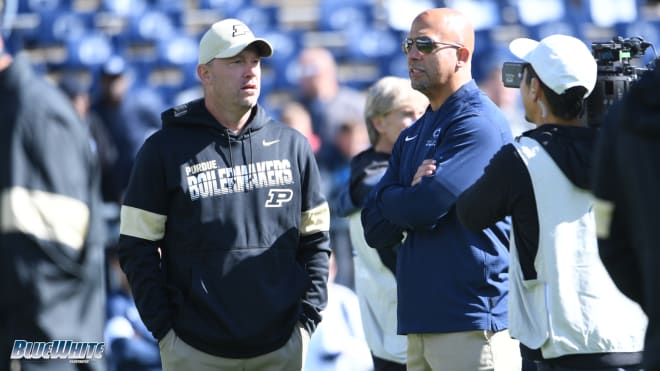Column: Throwback or a throwaway for Big Ten's spring options?
In the early 1990s, back when Penn State fans were still getting used to the idea of conference membership, there was a lot of concern that the Big Ten would be a step down for the football program. The Nittany Lions had been accustomed to challenging for national championships in the ’80s, but the Big Ten had a reputation as an insular little world in which member schools and their fans valued their own conference title more than the sport’s biggest prize and had an almost cultish devotion to the Rose Bowl, regarding the tradition-encrusted matchup against the Pac-10 champ as somehow more significant than any other bowl game could ever be, no matter what the pollsters and the TV ratings said.
It took three decades and a global pandemic, but we may finally be getting a season in which the Big Ten and the Pac-12 have the stage more or less to themselves.
On Tuesday, the Big Ten announced that it was postponing its 2020 season, and the Pac-12 followed suit shortly afterward. Both leagues have vowed to try again later in the academic year, with Big Ten commissioner Kevin Warren saying that “we’ll see what we can do from a spring standpoint.”

In the Big Ten’s decision, there were traces of that familiar sense of self-regard, the idea that if the game’s most historic institution acted unilaterally, everyone else would fall in line. And maybe that will eventually be the case. Maybe, when students start streaming back onto college campuses across the country, we’ll start seeing the kind of COVID spikes that will make a fall season untenable for any conference.
But for now, the Big 12, Atlantic Coast and Southeastern conferences seem quite willing to try to play in the fall. If they succeed in staging most or all of their regular-season games, they will hold a playoff and declare a national champion. Clemson’s Dabo Swinney has already said that the title won’t be devalued now that the Power Five, for the purposes of the coming fall season, has been reduced to the Power Three. “The four best teams can go play,” Swinney said. “We’ve been one of those four for five years in a row. So, in my opinion, it doesn’t change anything for us.”
Swinney’s point – that if Clemson is eligible, it’s a valid playoff – is sure to rub some people the wrong way. But he’s not wrong about the balance of power at college football’s highest levels. Since Ohio State defeated Oregon to win the inaugural College Football Playoff in 2014, the Big Ten and Pac-12 have gone a combined 0-4 in the CFP. Meanwhile, the SEC and ACC have combined to go 14-6 and have won five national championships.
And yet, there will absolutely be an asterisk associated with this year’s playoff if more than a third of the 66 teams in the current Power Five mix are sitting out. Who’s to say this wasn’t Ohio State’s year? Or Penn State’s? Or Oregon’s?
A better option, both for the legitimacy of the national title and quite possibly for the more important issue of protecting players and staffers from the coronavirus, would be for everyone to play in the spring. A number of Big Ten coaches have been floating trial balloons about how such a season could be conducted and how the obvious hurdles – the inhospitable winter weather, the roster fluctuations, the proximity to the 2021 season – could be overcome. James Franklin has proposed playing Big Ten games in domed stadiums within the league’s Midwestern footprint. Ohio State’s Ryan Day wants to begin in early January and be finished before the NFL Draft. Purdue’s Jeff Brohm has taken all of that spitballing and turned it into something concrete, producing a detailed plan for an eight-game regular season that extends from Feb. 27 to April 17, with a postseason tournament to follow, ending in mid-May.

Brohm’s seven-page proposal makes me think he ought to be America’s spring football czar. It’s got a color-coded calendar. It’s got a chart showing the average March temperatures in various Big Ten cities. It’s got a couple of pages devoted to health and safety considerations, both COVID- and football-related, including a plan to reduce the number of padded practices and lengthen rest periods to account for the possibility that athletes will end up playing two seasons in one calendar year. It also calls for the 2021 season to be shortened and delayed until early October.
Brohm’s proposed postseason features a Plan A – a Rose Bowl or a four-team playoff featuring the Big Ten and Pac-12 – and a Plan B – a six-team playoff featuring the Power Five conference champs and a wildcard team, with the top two seeds receiving first-round byes. It was smart to plan for multiple contingencies. College football has always been a coalition of interest groups rather than a top-down bureaucracy, and the past couple of weeks have shown just how decentralized its power structure really is. So the possibility that we’ll get all the Power Five conferences playing football at the same time this academic year is probably remote. But if it can be pulled off safely, even a split season, with the SEC, ACC and Big 12 fighting for the championship in the fall, and the Big Ten and Pac-12 going their own way in the spring, would be better than nothing. In some ways, it would seem like old times.
*******
• Talk about this article inside The Lions Den
• Watch our videos and subscribe to our YouTube channel
• Learn more about our print and digital publication, Blue-White Illustrated
• Follow us on Twitter: @BWIonRivals, @NateBauerBWI, @RivalsSnyder, @DavidEckert98, @ThomasFrankCarr
• Like us on Facebook